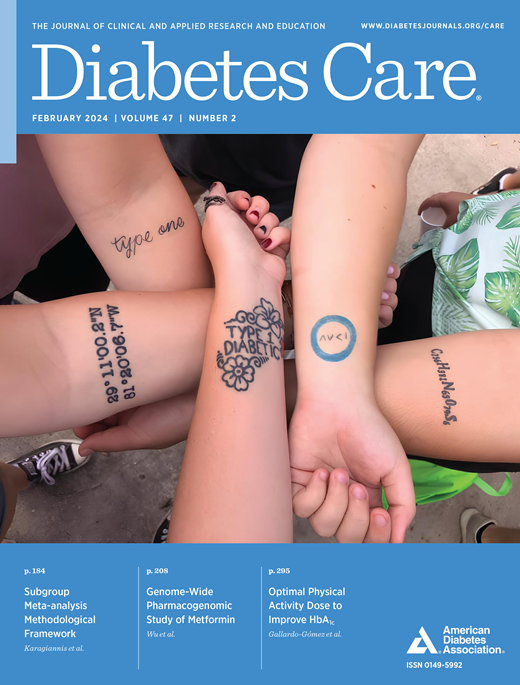One-Hour Plasma Glucose Predicts the Progression From Normal Glucose Tolerance to Prediabetes
IF 16.6
1区 医学
Q1 ENDOCRINOLOGY & METABOLISM
引用次数: 0
Abstract
OBJECTIVE To examine the ability of the 1-h plasma glucose (PG) concentration during the oral glucose tolerance test (OGTT) to predict the risk of progression to prediabetes in individuals with normal glucose tolerance (NGT). RESEARCH DESIGN AND METHODS A total of 1,557 participants from the San Antonio Heart Study who were free of type 2 diabetes at baseline, had a baseline OGTT, and had a repeat OGTT after 7.5 years of follow-up were evaluated. The ability of 1-h PG concentration to predict the development of prediabetes, based on American Diabetes Association criteria, was evaluated. RESULTS Approximately one-quarter of participants with NGT (24.7%) progressed to prediabetes at 7.5 years (22.5% with 1-h PG <155 mg/dL and 42.5% with 1-h PG >155 mg/dL). The 1-h PG was the strongest predictor of developing prediabetes, and a 1-h cut point of 120 mg/dL had 61% sensitivity and 67% specificity in identifying individuals with NGT at high risk of developing prediabetes. Participants with a 1-h PG of 120–155 mg/dL and who experienced a deterioration in glucose tolerance (progression to prediabetes) at follow-up were characterized by severe insulin resistance and metabolic abnormalities characteristic of the insulin resistance syndrome. Therefore, we suggest the term pre-prediabetes for this group to emphasize their high future risk of deteriorating glucose tolerance. CONCLUSIONS An increase in 1-h PG concentration precedes the development of prediabetes and identifies individuals with a 1-h PG of 120–155 mg/dL who are at increased risk of developing prediabetes. Therefore, we suggest the term pre-prediabetes for this group with an elevated risk of deteriorating glucose tolerance.一小时血糖预测从正常葡萄糖耐量到前驱糖尿病的进展
目的探讨口服糖耐量试验(OGTT)中1小时血浆葡萄糖(PG)浓度对正常糖耐量(NGT)患者进展为前驱糖尿病风险的预测能力。研究设计和方法共有1557名来自圣安东尼奥心脏研究的参与者,他们在基线时无2型糖尿病,进行基线OGTT,并在7.5年随访后进行重复OGTT。根据美国糖尿病协会的标准,评估1-h PG浓度预测糖尿病前期发展的能力。结果:大约四分之一的NGT参与者(24.7%)在7.5年时进展为糖尿病前期(1小时PG &;lt;155 mg/dL时22.5%,1小时PG &;gt;155 mg/dL时42.5%)。1小时PG是发展为前驱糖尿病的最强预测因子,1小时切割点为120 mg/dL在识别NGT患者具有发展为前驱糖尿病的高风险时具有61%的敏感性和67%的特异性。1小时PG为120-155 mg/dL的参与者在随访中经历了葡萄糖耐量的恶化(进展为糖尿病前期),其特征是严重的胰岛素抵抗和胰岛素抵抗综合征特征的代谢异常。因此,我们建议将这一群体称为前驱糖尿病,以强调他们未来糖耐量恶化的高风险。结论:1小时PG浓度的升高先于糖尿病前期的发展,并可识别1小时PG浓度为120-155 mg/dL的个体发生糖尿病前期的风险增加。因此,我们建议将糖耐量恶化风险升高的人群称为前驱糖尿病。
本文章由计算机程序翻译,如有差异,请以英文原文为准。
求助全文
约1分钟内获得全文
求助全文
来源期刊

Diabetes Care
医学-内分泌学与代谢
CiteScore
27.80
自引率
4.90%
发文量
449
审稿时长
1 months
期刊介绍:
The journal's overarching mission can be captured by the simple word "Care," reflecting its commitment to enhancing patient well-being. Diabetes Care aims to support better patient care by addressing the comprehensive needs of healthcare professionals dedicated to managing diabetes.
Diabetes Care serves as a valuable resource for healthcare practitioners, aiming to advance knowledge, foster research, and improve diabetes management. The journal publishes original research across various categories, including Clinical Care, Education, Nutrition, Psychosocial Research, Epidemiology, Health Services Research, Emerging Treatments and Technologies, Pathophysiology, Complications, and Cardiovascular and Metabolic Risk. Additionally, Diabetes Care features ADA statements, consensus reports, review articles, letters to the editor, and health/medical news, appealing to a diverse audience of physicians, researchers, psychologists, educators, and other healthcare professionals.
 求助内容:
求助内容: 应助结果提醒方式:
应助结果提醒方式:


